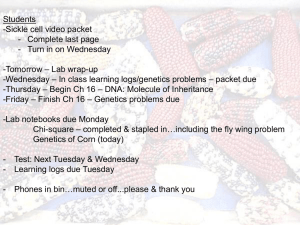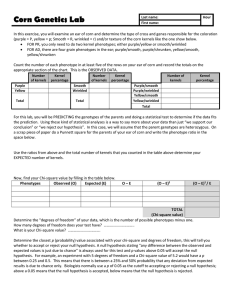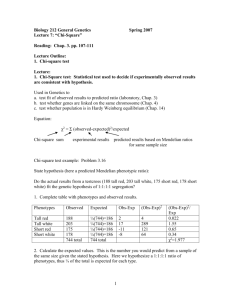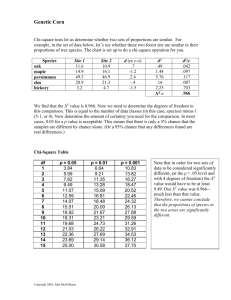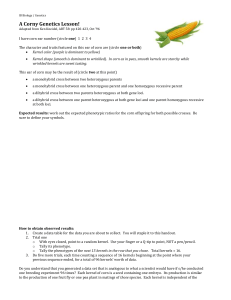Corn Genetics Lab
advertisement
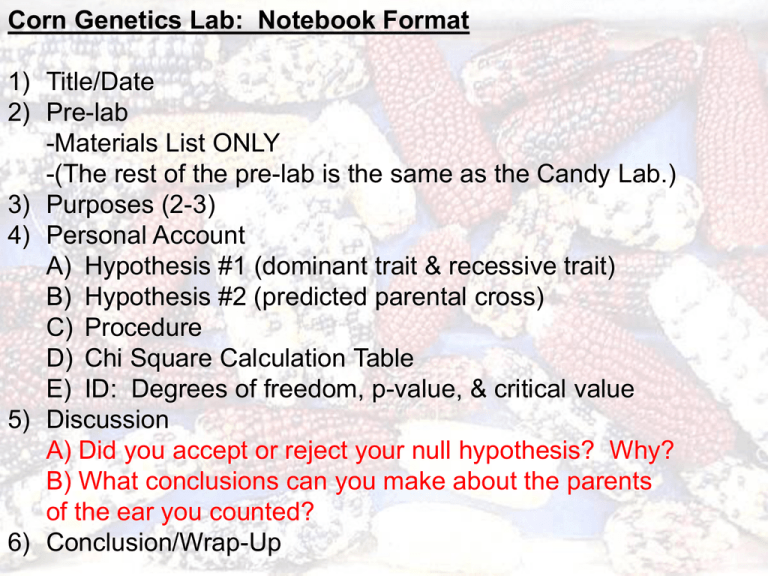
Corn Genetics Lab: Notebook Format 1) Title/Date 2) Pre-lab -Materials List ONLY -(The rest of the pre-lab is the same as the Candy Lab.) 3) Purposes (2-3) 4) Personal Account A) Hypothesis #1 (dominant trait & recessive trait) B) Hypothesis #2 (predicted parental cross) C) Procedure D) Chi Square Calculation Table E) ID: Degrees of freedom, p-value, & critical value 5) Discussion A) Did you accept or reject your null hypothesis? Why? B) What conclusions can you make about the parents of the ear you counted? 6) Conclusion/Wrap-Up Lab: Genetics of Corn – playing the role of Mendel 1. 2. 3. 4. Each set of partners should obtain one ear of corn. Study the ear and select 2 different traits that are easy to recognize. Make a chi-square table with the 4 possible phenotypes. Categorize the kernels on the entire ear by using tally marks for each of the 4 phenotypes. Use 1 pin to mark the row that you started on and another to mark the current row you are counting. 5. Count your tallies and record your data in the chi-square table. 6. Based on your observations of kernels and the ratios you counted, hypothesize which traits are dominant & which are recessive. Then hypothesize the genotypes of the parents that created the ear that you just counted. This will allow you to predict a ratio/number of offspring from the total number of kernels counted…your “expected data.” 7. Complete your chi-square table & calculate chi-square by including your null hypothesis, degrees of freedom and p value. Critical Values of the Chi-Square Distribution Degrees of Freedom (df) Probability (p) 1 2 3 4 5 0.05 3.84 5.99 7.82 9.49 11.1 0.01 6.64 9.21 11.3 13.2 15.1 0.001 10.8 13.8 16.3 18.5 20.5 Lab 7 alternative: Genetics of Corn – playing the role of Mendel 1. 2. 3. 4. 5. 6. 7. 8. 9. Each set of partners should obtain one ear of corn. Study the ear and select 2 different traits that are easy to recognize. Make a chi-square table with the 4 possible phenotypes. Categorize the kernels on the entire ear by using tally marks for each of the 4 phenotypes. Use 1 pin to mark the row that you started on and another to mark the current row you are counting. Count your tallies and record your data in the chi-square table. Based on your observations of kernels and the ratios you counted, hypothesize which traits are dominant & which are recessive. Then hypothesize who the parents were that created the ear that you just counted. (This is basically what Mendel had to do with the peas.) This will allow you to predict a ratio/number of offspring from the total number of kernels counted. Complete your chi-square table & calculate chi-square by including your null hypothesis, degrees of freedom and p value. Did you accept or reject your null hypothesis? Why? What conclusions can you make about the parents of the ear you counted?
